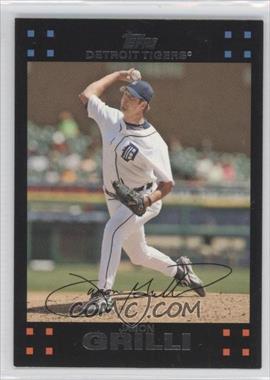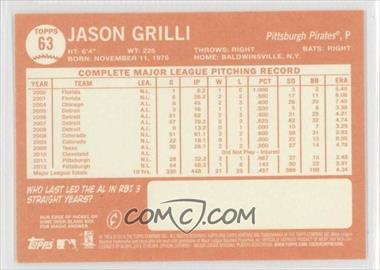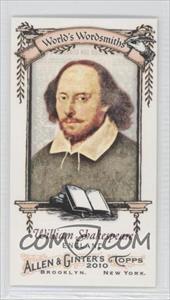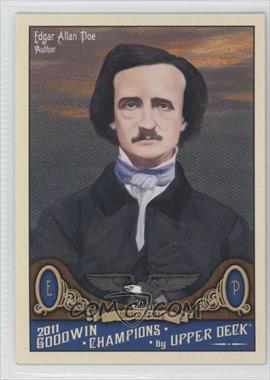
What Can We Steal From Jason Grilli’s 2007 Topps Card?
Title of Work and its Form: Jason Grilli‘s 2007 Topps #61, baseball card
Author: Topps
Date of Work: 2007
Where the Work Can Be Found: You likely have a baseball/sports card shop in your area. Why not pay them a visit? They will likely have this base card. If you don’t know where you can find your local card shop, look it up here. You can also purchase cards on the Internet, of course. Check Out My Cards/Collectibles is pretty cool. (And they furnished the card images you’ll see in the essay.) I also love Sportlots.com; you can get a lot of base cards for a very reasonable price. Ooh, and don’t forget to visit The Bench. It’s hands-down the best baseball card trading site on the Internet. I’ve met a TON of really cool people there.
Bonuses: Mr. Grilli was on the cover of Sports Illustrated in July 2013! Here is an article about how he and the rest of the Pirates bullpen anchored that team’s great season. Here is Mr. Grilli’s home page. You can also follow him on Twitter. Here are Mr. Grilli’s career stats. In October 2013, Mr. Grilli went onstage with Pearl Jam during a Pittsburgh concert and did, well, everything we would do in the same situation. Check out the Sports Cards Blogroll for some very good writing about the hobby and about sports. A couple of my favorite card blogs are Baseball by the Letters and The Greatest 21 Days. The former blog follows the authors experience in writing letters to ballplayers. The latter goes card-by-card through a classic minor league set to see what happened to the players during and after their baseball careers.
Element of Craft We’re Stealing: Characterization
Discussion:
Let me guess. You don’t have a 2007 Topps Jason Grilli sitting on your desk. Thanks to Check Out My Cards, this isn’t a problem:


So, some readers may wonder what the heck writers can learn from a baseball card. Sure, there are some words on it, but is a baseball card a work of literature? I would contend that a baseball card performs many, if not all, of the functions of literature. (One of my long-term goals/dreams, in fact, is to write at least one real baseball card. I need to figure out how to make that happen! Black magic? Some kind of Manchurian Candidate deal?)
A baseball card is an attempt to represent a player’s identity. The kind folks at Topps or Upper Deck or Panini or Score or Donruss or Fleer consider what they want the reader to think about the man. Some of the exposition we get is pretty shallow. We learn Mr. Grilli’s birthdate and which arm he uses to throw and where he was born and where he lives. (It just so happens that Mr. Grilli was born near my place of birth and grew up in the same town as I did. More on that later.)
The folks at the card companies very seldom tell the complete stories of the players. Why? First of all, the cards are too small to fit an utterly comprehensive biography. Further, the companies want to maintain a positive tone. This is why you really don’t see the steroids scandal mentioned on any cards and you certainly don’t read anything about the crimes that various players have committed. (Ty Cobb, for example, once beat up a handicapped spectator who had no hands.)
Topps, however, gives the reader the opportunity to figure out some of the true story for themselves. Look at the statistics Mr. Grilli has accumulated in the major leagues.
Year Age Tm Lg W L W-L% ERA G GS GF CG SHO SV IP H R ER HR BB IBB SO HBP BK WP BF ERA+ WHIP H/9 HR/9 BB/9 SO/9 SO/BB Awards
2000 23 FLA NL 1 0 1.000 5.40 1 1 0 0 0 0 6.2 11 4 4 0 2 0 3 2 0 0 35 86 1.950 14.9 0.0 2.7 4.1 1.50
2001 24 FLA NL 2 2 .500 6.08 6 5 1 0 0 0 26.2 30 18 18 6 11 0 17 2 0 0 115 71 1.538 10.1 2.0 3.7 5.7 1.552004 27 CHW AL 2 3 .400 7.40 8 8 0 1 0 0 45.0 52 38 37 11 20 0 26 3 0 2 203 64 1.600 10.4 2.2 4.0 5.2 1.30
2005 28 DET AL 1 1 .500 3.38 3 2 0 0 0 0 16.0 14 6 6 1 6 0 5 0 0 0 63 128 1.250 7.9 0.6 3.4 2.8 0.83
2006 29 DET AL 2 3 .400 4.21 51 0 18 0 0 0 62.0 61 31 29 6 25 3 31 5 0 5 270 108 1.387 8.9 0.9 3.6 4.5 1.24
2007 30 DET AL 5 3 .625 4.74 57 0 13 0 0 0 79.2 81 46 42 5 32 1 62 5 0 5 352 97 1.418 9.2 0.6 3.6 7.0 1.94
2008 31 TOT MLB 3 3 .500 3.00 60 0 16 0 0 1 75.0 67 27 25 2 38 7 69 2 0 4 323 156 1.400 8.0 0.2 4.6 8.3 1.82
2008 31 DET AL 0 1 .000 3.29 9 0 4 0 0 0 13.2 12 5 5 1 7 1 10 1 0 1 59 138 1.390 7.9 0.7 4.6 6.6 1.43
2008 31 COL NL 3 2 .600 2.93 51 0 12 0 0 1 61.1 55 22 20 1 31 6 59 1 0 3 264 160 1.402 8.1 0.1 4.5 8.7 1.90
2009 32 TOT MLB 2 3 .400 5.32 52 0 11 0 0 1 45.2 50 27 27 4 27 2 49 1 0 2 212 89 1.686 9.9 0.8 5.3 9.7 1.81
2009 32 COL NL 0 1 .000 6.05 22 0 6 0 0 1 19.1 29 13 13 2 13 2 22 0 0 2 99 79 2.172 13.5 0.9 6.1 10.2 1.69
2009 32 TEX AL 2 2 .500 4.78 30 0 5 0 0 0 26.1 21 14 14 2 14 0 27 1 0 0 113 98 1.329 7.2 0.7 4.8 9.2 1.932011 34 PIT NL 2 1 .667 2.48 28 0 4 0 0 1 32.2 24 10 9 2 15 5 37 4 0 3 140 151 1.194 6.6 0.6 4.1 10.2 2.47
2012 35 PIT NL 1 6 .143 2.91 64 0 11 0 0 2 58.2 45 20 19 7 22 4 90 2 0 0 244 130 1.142 6.9 1.1 3.4 13.8 4.09
2013 36 PIT NL 0 2 .000 2.70 54 0 41 0 0 33 50.0 40 15 15 4 13 0 74 1 0 1 202 131 1.060 7.2 0.7 2.3 13.3 5.69 AS
11 Yrs 21 27 .438 4.17 384 16 115 1 0 38 498.0 475 242 231 48 211 22 463 27 0 22 2159 104 1.378 8.6 0.9 3.8 8.4 2.19
162 Game Avg. 4 5 .438 4.17 65 3 20 0 0 6 85 81 41 39 8 36 4 79 5 0 4 367 104 1.378 8.6 0.9 3.8 8.4 2.19DET (4 yrs) 8 8 .500 4.31 120 2 35 0 0 0 171.1 168 88 82 13 70 5 108 11 0 11 744 105 1.389 8.8 0.7 3.7 5.7 1.54
PIT (3 yrs) 3 9 .250 2.74 146 0 56 0 0 36 141.1 109 45 43 13 50 9 201 7 0 4 586 135 1.125 6.9 0.8 3.2 12.8 4.02
COL (2 yrs) 3 3 .500 3.68 73 0 18 0 0 2 80.2 84 35 33 3 44 8 81 1 0 5 363 128 1.587 9.4 0.3 4.9 9.0 1.84
FLA (2 yrs) 3 2 .600 5.94 7 6 1 0 0 0 33.1 41 22 22 6 13 0 20 4 0 0 150 73 1.620 11.1 1.6 3.5 5.4 1.54
TEX (1 yr) 2 2 .500 4.78 30 0 5 0 0 0 26.1 21 14 14 2 14 0 27 1 0 0 113 98 1.329 7.2 0.7 4.8 9.2 1.93
CHW (1 yr) 2 3 .400 7.40 8 8 0 1 0 0 45.0 52 38 37 11 20 0 26 3 0 2 203 64 1.600 10.4 2.2 4.0 5.2 1.30NL (7 yrs) 9 14 .391 3.45 226 6 75 0 0 38 255.1 234 102 98 22 107 17 302 12 0 9 1099 119 1.336 8.2 0.8 3.8 10.6 2.82
AL (6 yrs) 12 13 .480 4.93 158 10 40 1 0 0 242.2 241 140 133 26 104 5 161 15 0 13 1060 93 1.422 8.9 1.0 3.9 6.0 1.55
Provided by Baseball-Reference.com: View Original Table
Generated 12/13/2013.
If you understand what the numbers mean, they tell a story and add detail to the “characterization” of Mr. Grilli. He made his debut in 2000, only a few years after graduating from college (and my high school). That’s good! I remember being proud of him when he won that game. Mr. Grilli pitched in six games the next year. That’s not necessarily bad…it was only his Age 24 year. Then he was out of the majors for a couple years. How would any of us feel in his situation. He must have been confident, but still worried he wouldn’t be able to get back to the majors. Then he did get back to the show in 2004. Now look at the number of games in which he pitched in Detroit. That’s a lot! The team was emerging from the doldrums (thank goodness) and Mr. Grilli was a reliable reliever for them. After a stop in Colorado and Texas…he was out of the majors for the 2010 season. Again-doubt. (The card doesn’t say so, but that’s when Mr. Grilli suffered an unpleasant knee injury.) Pittsburgh time. Mr. Grilli puts up sub-3.00 ERAs each year. Look at those save totals! In his first year as the Pirates’ official closer, Mr. Grilli was responsible for 33 saves. That’s good!
What do we learn about Mr. Grilli from these raw numbers? Well, he must love baseball. Why else would he struggle for so long and fight through so many setbacks? Lefty relievers have a little bit easier time finding places on a roster; as a righty, Mr. Grilli must have worked that much harder. Now, I don’t know if Mr. Grilli has multiple homes (and why shouldn’t he), but his 2013 Heritage card says that he still lives in Baldwinsville, New York, a beautiful little village just outside of Syracuse:

How does all of this apply to writers? Well, I’ve demonstrated how baseball cards are very good at condensing a LOT of information about a person into a very small space. Even if your characters don’t have “statistics,” think of ways to provide bread crumbs of information that reinforce the identity you’re crafting for them. Favorite foods. Number of years on the job. Number of marriages. Number of colleges they attended before finally finishing. Number of boyfriends or girlfriends over the years. Highest number of simultaneous boyfriends or girlfriends.
Now let’s take a look at the prose on the 2007 Topps. Like I said, I always kept tabs on Mr. Grilli’s career because he was a great pitcher…I loved pitching (until I stopped playing at nine or so). His father is Steve Grilli, a man who pitched for the Tigers in the 1970s…I love the Tigers. Jason Grilli went to my high school…I hoped to be a success, too. (I’m still hoping.) Jason Grilli is having the best years of his career and has become a star, even though he’s on the wrong side of 30…I’m a writer, so age isn’t as big a deal…but I’d still like to get something going sooner rather than later.
The prose offers a pretty obvious lesson. Being such an important part of that great 2006 Tigers team, “helped erase the frustration of years of elbow problems.” Writers and pitchers are quite different, but we all need to emulate Mr. Grilli’s routines. He works out all the time and has a throwing regimen crafted to keep him in shape during the offseason and to keep him fresh at the end of the year. He must watch game footage and study batters to try and understand their weaknesses. During some of Mr. Grilli’s struggles, it must have seemed like the majors were far away, let alone the postseason. (He has a 0.00 ERA in 6.1 total innings.) Like him, we just need to plug away every day so we can be in the right position when we run into a little bit of luck. Mr. Grilli was picked up by the Tigers and the Pirates as those teams were getting better and he was able to contribute because of his regimen.
Now let’s look at the sentences. You’ll notice that they’re all pretty simple. Why might this be the case? Well, this is a baseball card and is intended for an audience of adults (who have money) and of children (who tell their parents how to spend money). Although some sets feature prose that is intended for children, the Topps flagship sets are written for a mixed audience.
Look at the last sentence: “The converted starter limited first-batters-faced to a .170 batting average.” A pronoun would have been just fine in this situation, but the person who wrote the card used a more specific term than “he.” Instead, “he” was described as “the converted starter.” Not only did the writer avoid using another pronoun, but he or she was able to pack more characterization into the small space allotted by the medium. The reader learns from this switch that Mr. Grilli was a starter and is now a reliever. (And that he was really good against the first batters he stared down in each game.)
What Should We Steal?
- Offer your reader powerful characterization in the form of “statistics.” What are some small details about your character that are especially potent?
- Maintain your daily regimen and keep writing until something good happens. You can’t manufacture “luck.” All you can do is make sure that you have a really cool manuscript ready to go when you happen to sit next to an editor on an airplane.
- Replace pronouns with more powerful descriptors.
Here’s some more fun stuff:
Night Owl Cards (another favorite blog) wrote a post about a series of baseball cards dedicated to baseball writers.
And believe it or not, the major card companies have included some great scribes in some of their sets!


